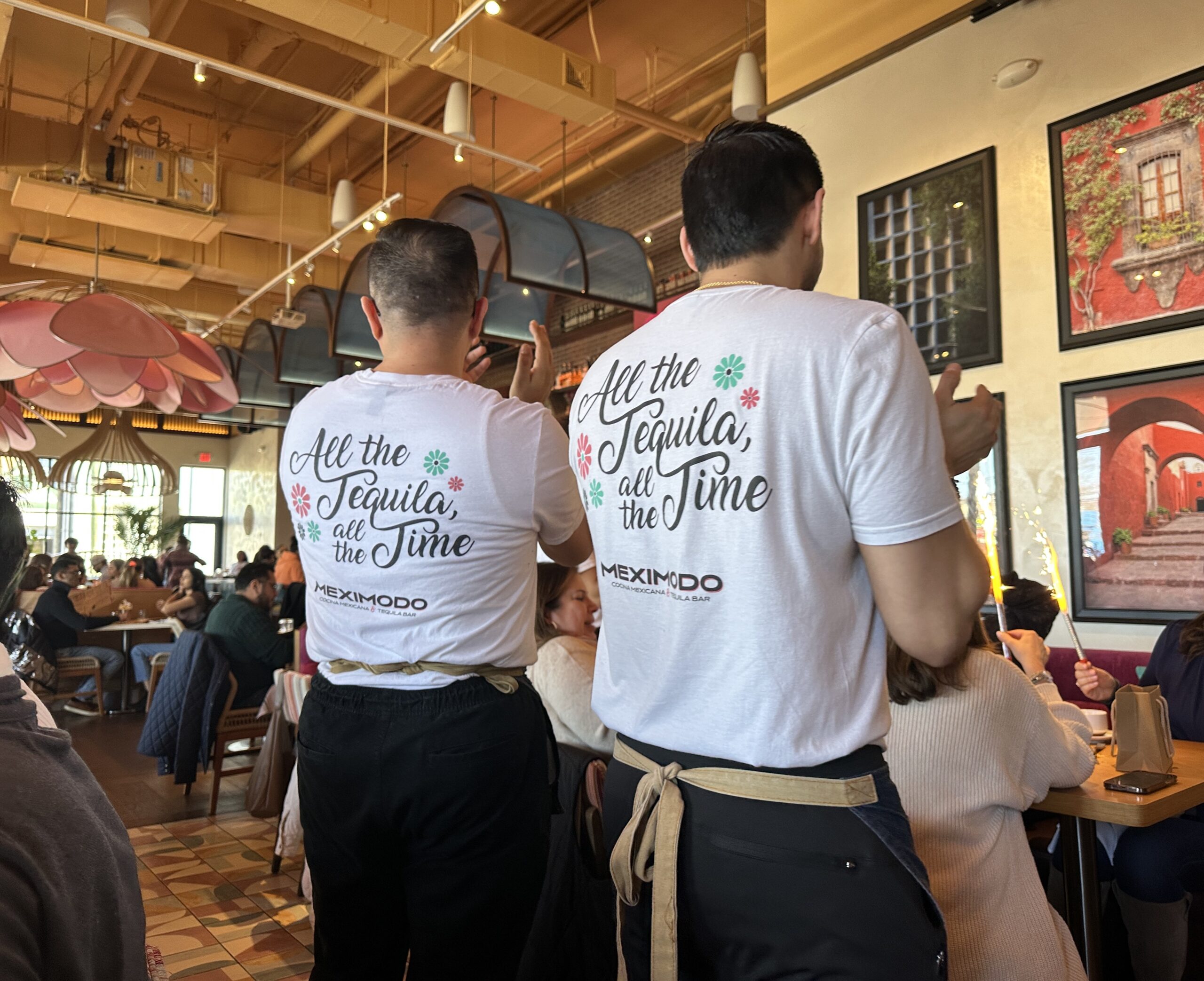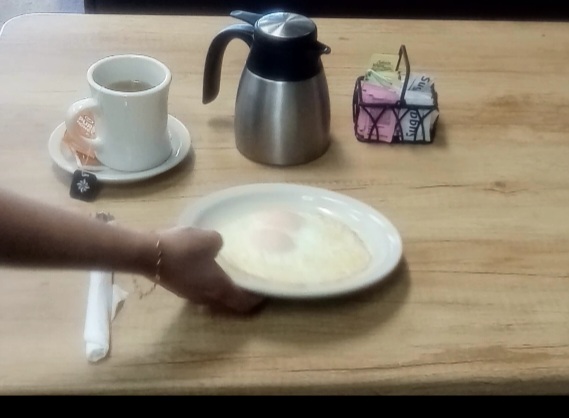Olivia Karny knew something needed to change in her local skateboarding community in Montclair, New Jersey. A teenager bound for Carnegie Mellon University in the fall, she started skateboarding over a year and a half ago. She became interested in it while dating someone who skated. Her fascination with the sport grew from there. Eventually, she bought her own skateboard. “It was the best thing I’ve ever done,” she said.
Karny wanted to see more women, girls, and non-binary people skateboarding in her hometown after attending an all-girls summer skateboarding event hosted by Shred.Co with a friend, Devon Hoskins. Karny did not see any female skateboarding instructors at the event, and it saddened her. While still there, Karny and Hoskins decided they needed to do something about this. They talked about running skate events, creating a name and a logo, and getting their name out on Instagram. This moment became the starting point for Boardroom Skate, a skateboarding organization that serves as a space for women, girls, and non-binary people to meet up and skate in a supportive and comfortable environment in a sport that has historically been male dominated.
Today, Karny runs Boardroom Skate and hosts weekly skateboarding meet-ups for women, girls, and non-binary people on Saturdays from 10 a.m. to noon at the Rand Courts in Montclair. Over a period of months, Karny aspired to learn how to ollie, a technique in which a skateboarder kicks the tail end of the board down while jumping in order to make the board pop in the air. And this learning process further motivated her to continue developing Boardroom Skate.
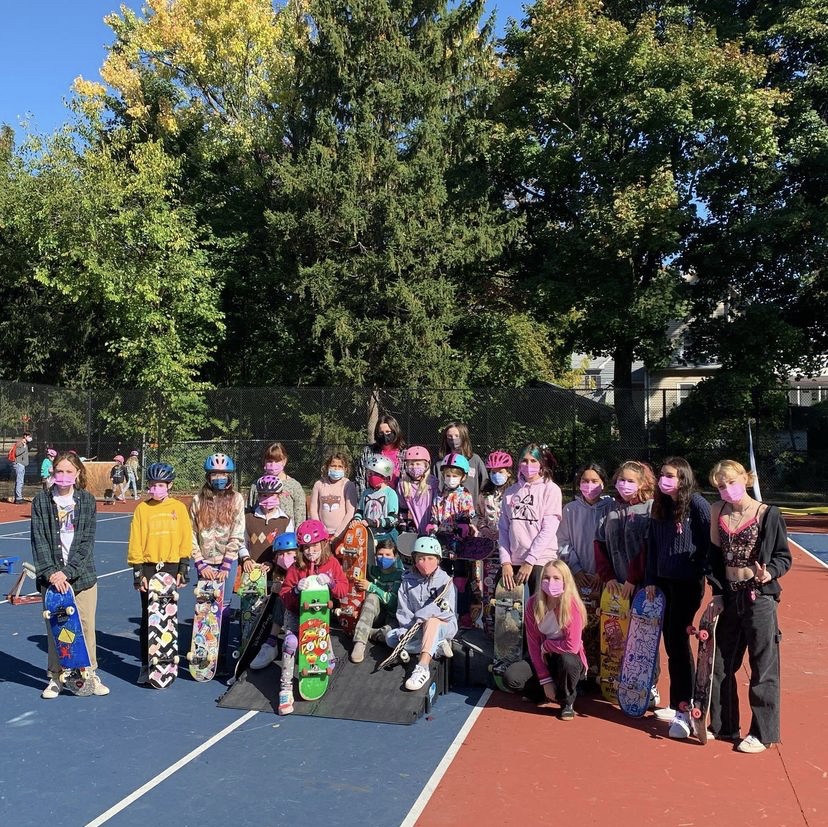
Olivia Karny, standing in the center right with a pink T-shirt and mask, poses for a photo along with attendees of the Boardroom Skate event on Saturday, October 17, 2020, in Montclair, New Jersey. [Credit: Olivia Karny and Boardroom Skate ; Instagram: @boardroomskate]
Her goals to create change mirror the growth that has taken place throughout the sport from the 1950s until today. The activity that once started as a counterculture dominated in mainstream representations by boys and men is growing into a more inclusive sport with representation by more women and people in the LGBTQ+ community. The expansive history of the sport helps to chronicle these changes.
A Brief History of Skateboarding
Skateboarding became more popular in California in the late 1950s and early 1960s among mostly surfers, according to Professor Iain Borden, a skateboarder himself and architectural historian at University College London who wrote Skateboarding and the City: A Complete History. They wanted an experience to mimic surfing on land, and so they strapped roller skate wheels onto wooden boards. “Sidewalk surfing” was born. The early 1960s was also a boom time for skateboarding in terms of downhill slalom and freestyle competitions where trailblazers like Woody Woodward and Torger Johnson skated.
In addition to the success of male skaters, there were also female skaters who gained notoriety for their skill. In 1964, Patti McGee became the first woman to win the National Skateboarding Championships. She was featured on the cover of Life magazine in May 1965 and became the first professional female skateboarder that same year. Skateboarding eventually lost some momentum and declined in popularity, but found a reversal of fortunes in the early 1970s when Frank Nasworthy revolutionized the sport through the introduction of polyurethane wheels.
“Nasworthy realized that if you use polyurethane, you get a much smoother, faster, gripper, more controllable wheel,” Borden said. “And then there’s some other advances made in the trucks … and the deck gets bigger and they start using different materials. And that’s when skateboarding really takes off,” Borden said.
In 1975, skateboarding got another boost with the emergence of the Zephyr Competition team, also known as the Z-Boys. At the Del Mar National Championships in Del Mar, California, the skaters rode their boards low to the ground and incorporated surfing styles onto their skateboards.
The group, which consisted of notable male skaters Nathan Pratt, Stacy Peralta, Jay Adams and Tony Alva, among others, gained additional notoriety through the 2001 documentary Dogtown and Z-Boys. They were inspired by surfer Larry Bertlemann in their skateboarding style.
“He was the best surfer in the world in like 1973 and ‘72. We were just trying to copy him. You know, do Bertlemann stuff on asphalt,” Pratt said.
While emulating Bertlemann, Pratt and his friends left their own unique imprint on the world of skateboarding.
“I guess the thing we did that was kind of our donation to the cause was the whole idea of aerial and vertical skateboarding. So really, all the variations from that that have come through to current day. So, you know, we were the first guys to do the real vertical riding in the pools, and then doing the aerials in the pools and doing aerials off the tops of buildings and stuff,” Pratt added.
Their skating prowess is also memorialized in the 2005 Hollywood film Lords of Dogtown. In addition to these young skaters grabbing the public’s attention, Peggy Oki made progress for women in the sport by being a member of this same historic Zephyr team. Her presence planted the seeds of change for future generations.
As the ‘70s ended and the ‘80s rolled in, signs of change began to emerge in the sport.
The Hags, an all-girl punk rock skateboarding group, emerged in West Los Angeles in the early 1980s. They were, in many ways, a precursor to Karny’s Boardroom Skate.
Karny’s new developments to the local skateboarding landscape of Montclair also reflect the topographical and regional changes that swept through the sport in the ‘80s. Skaters, according to Borden, began finding a new terrain to conquer: city streets. The skateboarding sprawl grew into new cities like Sacramento, Philadelphia and New York. “Suddenly, you don’t need a surf culture. You don’t need a big skate park. You can literally do it anywhere,” Borden said.
The ‘80s also saw the rise of Bones Brigade, a group of male skaters including Stacy Peralta (from the ‘70s Zephyr team), Tony Hawk, Rodney Mullen and Steve Caballero, among others, who dominated competitive skateboarding competitions. In addition to winning events, the crew documented their skill with The Bones Brigade Video Show, an amateur skateboarding video directed by Peralta that sold 30,000 copies. After the release of the first video in 1983, Peralta went on to record subsequent videos in the years to follow. The Bones Brigade videos were sold across the world and introduced a new generation to skateboarding.
In the 1990s, transgressive street skating was prominent, according to Borden. This was also a time when Elissa Steamer, a skateboarder in the LGBTQ+ community, gained recognition for her appearance on Toy Machine’s “Welcome to Hell” 1996 skateboarding video. This was the first time a female skater had “a street part in a major skate video.” Steamer went on to have continued success in skateboarding by turning pro in the late ‘90s, winning four X Games gold medals in the 2000s and being featured as the first female skater in Tony Hawk’s Pro Skater video game series, among other accomplishments. Steamer paved the way for future generations of skaters like Karny and the members of Boardroom Skate.
By the end of the decade, more progress was made for female skateboarders as women’s competitions were added to Slam City Jam, the North American skateboarding championships, in 1999.
The commercial and mainstream success of skateboarding continued to balloon in the ‘90s when ESPN aired the first ever X Games in 1995. Gary Ream, the chairman of the World Skate Skateboarding Commission and a major participant in the formation of USA Skateboarding, said the X Games’s elevation of competition for a national and global broadcast was very good for skateboarding “because it provided more opportunities around the globe for people to skateboard in areas that are constructed and funded by governments (and) rec (recreational) departments … providing skate facilities just like they do basketball courts and tennis courts.”
As the 21st century arrived, female skateboarders continued to advocate for change in the sport. Jen O’Brien and Cara-Beth Burnside pushed for female skateboarders to be included in the X Games after being excluded from the first seven games. In 2003, women’s skateboarding events were added to the competition. After learning that male skaters who won at the X Games received more money than female winners, O’Brien and Burnside organized a women’s boycott of the 2005 X Games and helped to win equal pay for women in 2008.
With the 2000s rolling into the 2010s, more victories were won for inclusivity in the sport. Leo Baker created NYC Skate Project, which in similar fashion to Karny’s Boardroom Skate, is a “intentional space for gender non-conforming, trans folx, non-binary folx, and cis-women who skate.” In 2013, Latosha Stone started Proper Gnar, the first Black woman-owned skateboarding company.
As the sport continues to grow and progress in the 21st century, so too has the terrain in at least one major city. Ian Clarke, who founded a community-based organization called NYC Skateboard Coalition, has worked closely with New York City Department of Parks and Recreation officials to change the landscape of the city’s skateboarding scene by advocating for “well-balanced skateparks” that have “a bit of everything.”
New York City’s skateparks have seen progression that Clarke is happy about. Pier 62 Skatepark in Chelsea opened in 2010. It was New York City’s “first modern, full-sized vert concrete transition skatepark” when it opened. “Vert skating” is a style of skating when a skater transitions from a horizontal surface to a vertical surface in order to do grinds and airborne tricks. “This is the greatest skate park in New York by far,” Clarke said.
He noted “the natural forces of the organic growth of skateboarding in New York,” adding that there are many more women skateboarding and that people of all genders are represented.
The Road to Tokyo
The evolution of skateboarding from “sidewalk surfing” to today’s skateparks are on display in the Olympic Games. It’s been a long road to Tokyo, beginning in the early 2000s when Ream told the International Olympic Committee that skateboarding was a sport they should keep their eye on.
The odyssey concluded in 2016, when Ream was at the Games in Rio de Janeiro, and heard the news that the sport would be included in Tokyo. The decision to include skateboarding and the other new sports at the Tokyo Games had financial incentives, according to Ream. The IOC needed to keep younger audiences interested because the age of their viewers continued to get older.
As for Clarke, he admits that having skateboarding in the Olympics is an awkward fit, but does see a benefit to the sport being included. “I think overall, it’s for the greater good ‘cause we’re all about getting skateparks built and better skateparks built, especially in New York, of course. And we feel the Olympics will go towards helping that,” he said.
Borden sees another benefit and it is one that harkens back to Karny’s motivation to create Boardroom Skate. “Skateboarding likes to see itself as inclusive,” Borden said. “But there are a number of ways in which it isn’t.” He said the sport may not be outrightly sexist or homophobic, but it projects a certain image — the white, heterosexual, able-bodied, male skater — especially in transgressive street skating.
“The industry is dominated by representations of people that look like that. But female skaters and queer skateboarders and skaters … who are not able-bodied, at least until the last few years, have not really figured in … the media mainstream representations of skateboarding,” he said.
He added that the Olympics is giving “absolute, equal billing” to female competition as they are to male competition.
Montclair’s Boardroom Skate and Shred.Co
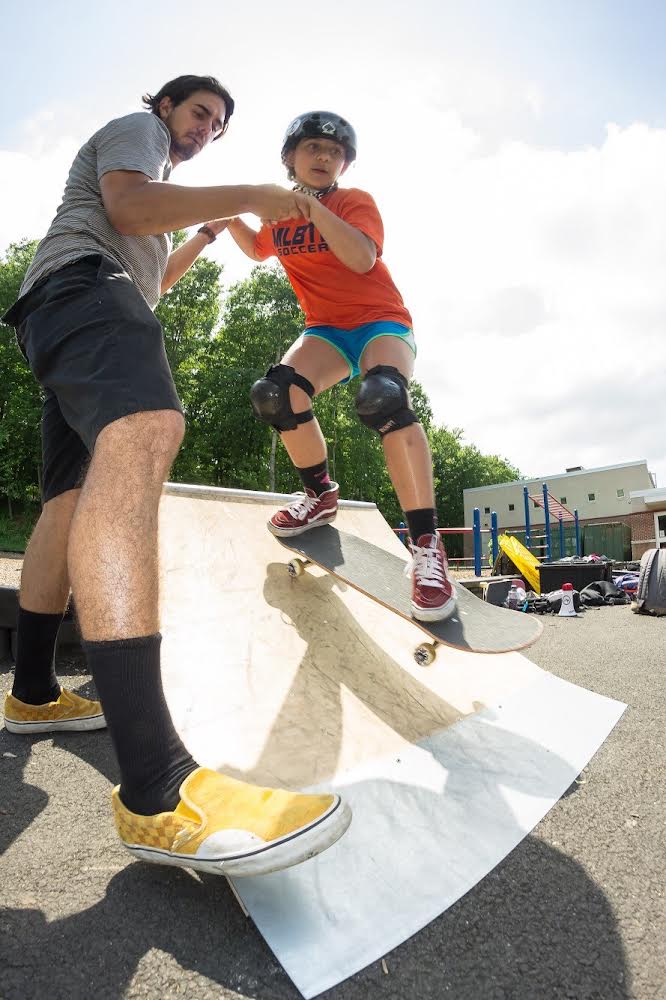
Evan Dittig, left, assists Grace at Shred.Co’s after school skate program in Boonton, New Jersey, in May 2018. [Credit: Jordan Galiano; Instagram: @galianophoto
Regarding Boardroom Skate, Dittig said, “It’s really cool to see ‘cause like the girls have their own crew …. and are really accepting to young girls. Parents ( and) moms, they all want to come skate and link up and it’s a really cool, safe and inclusive space for female skateboarders.”
The walls of his home are adorned with homages to skateboarding — skate photography and boards decorate the interior. He began skating at age 11 with a hand-me-down skateboard from his cousins and eventually taught himself how to skate. His company offers daily skateboarding lessons to people of all ages and has done outreach efforts internationally. Dittig also teaches skateboarding as a therapeutic respite to people battling addiction and depression and was the person who initially recommended that I reach out to Karny.
“I’m stoked that the Olympics will come because I know that there are going to be all these people that want to skate and there’s going to be more opportunities to get skateboarding in the eye of the public…,” he said. He added that there will be an influx of people wanting to learn how to skate after the Olympics and that this will be good for his business because they are ahead of the curve in teaching people the sport.
Dittig said the demand for skateboarding is high. He and his instructors are booked every day from now until after Thanksgiving. He hopes that by the year’s end, his company will have an indoor space where kids can learn and progress in skateboarding.
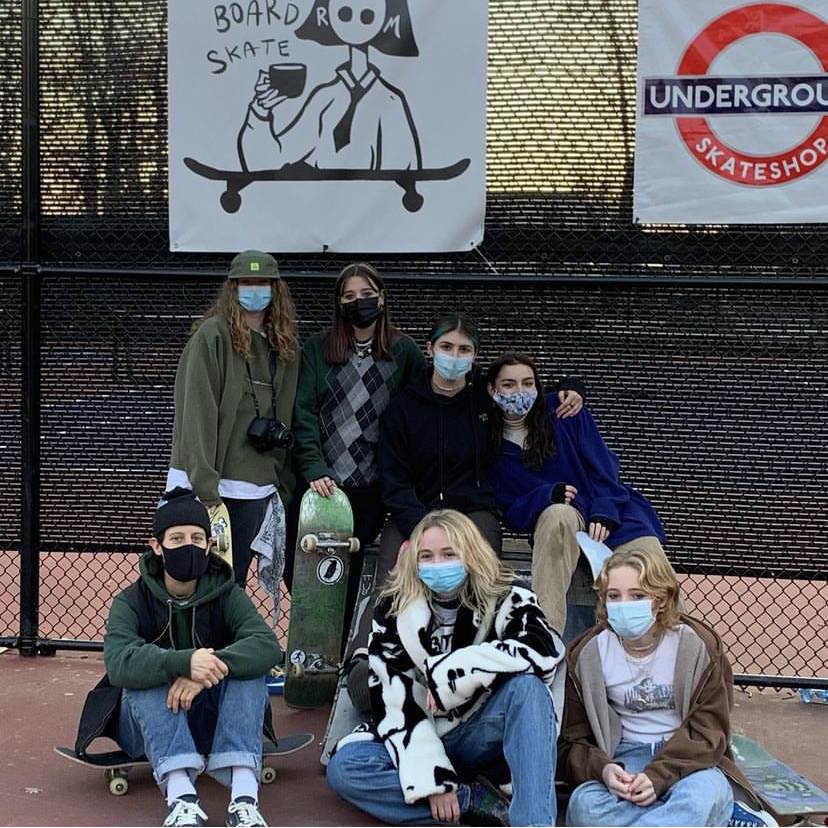
Olivia Karny and fellow skaters pose for a picture with Alexis Sablone, seated far left, at Rand Park in Montclair, New Jersey, in January 2021. Sablone, who finished fourth in the women’s street skating event in Tokyo for Team USA, is a seven-time X Games medalist. [Credit: Olivia Karny and Boardroom Skate; Instagram: @boardroomskate]
“When I was able to meet her, I kind of just felt that in her presence, that, you know, she’s a strong, powerful … woman and that I can take that from her and also embody that. And then teach these younger girls that I communicate with every day … that they can grow up and they can be a big, powerful woman, and that nothing should be able to stop them,” Karny said.
As skateboarders continue to hit the courses in Tokyo, they are probably doing familiar tricks, but representing a sport whose future won’t look like its past.
To learn more about Boardroom Skate and Shred.Co, check out their websites at boardroomskate.com and theshred.co. Instagram: @boardroomskate ; @shred.co
![A Boardroom Skate flyer announces the next Saturday skate session for the group on Saturday, July 31, 2021, at the Rand Courts in Montclair, New Jersey. [Credit: Olivia Karny and Boardroom Skate ; Instagram: @boardroomskate]](https://theclick.news/wp-content/uploads/cache/2021/08/Olivia-Karny-Photo-4/3841079067.jpg)
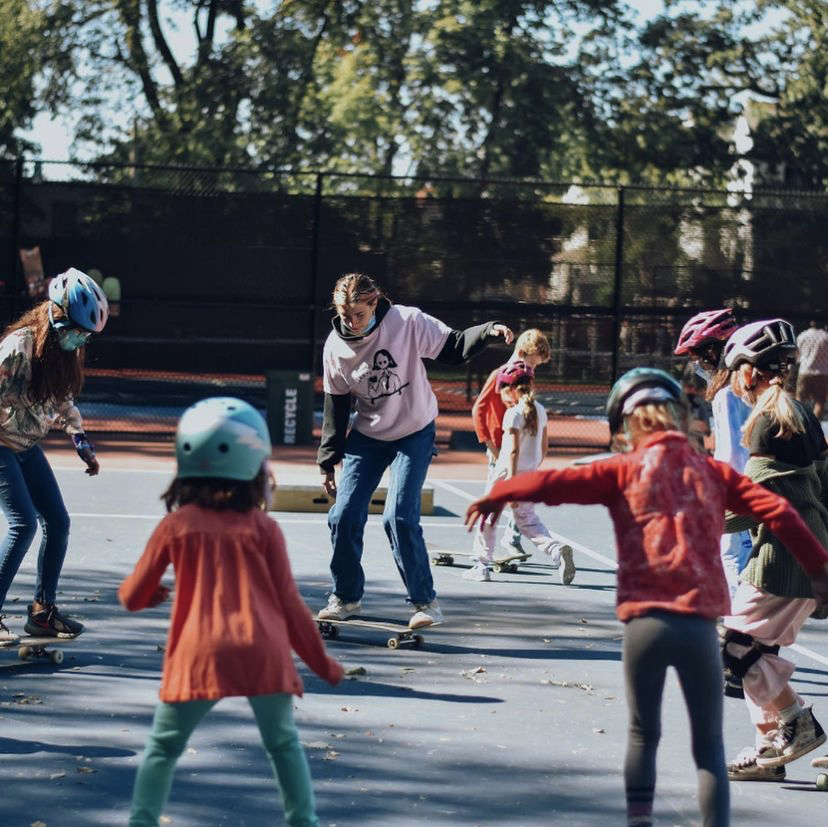
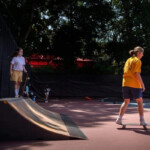
![Evan Dittig skates in Fairfield, New Jersey, on a street filming session in December 2020. [Credit: Jordan Galiano ; Instagram: @galianophoto]](https://theclick.news/wp-content/uploads/cache/2021/08/Evan-Dittig-Photo-3/3279323418.jpeg)
